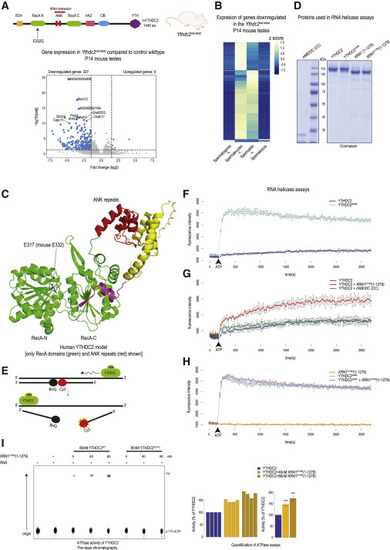Fig. 3
- ID
- ZDB-FIG-220718-3
- Publication
- Li et al., 2022 - The XRN1-regulated RNA helicase activity of YTHDC2 ensures mouse fertility independently of m6A recognition
- Other Figures
- All Figure Page
- Back to All Figure Page
|
Figure 3. The essential 3′→5′ RNA helicase activity of YTHDC2 is modulated by XRN1 (A) Creation of the RNA helicase catalytic-dead Ythdc2cat-dead mouse mutant with the E332Q mutation in the N-terminal RecA domain. See also Figure S3A. Volcano plot showing differential testicular gene expression analysis between wildtype and Ythdc2cat-dead helicase mutant P14 mice. Significant genes (padj < 0.05 and log2FC > 1.5 or log2FC < −1.5) are shown in blue. (B) Heatmap showing the expression pattern of significantly dysregulated genes (from the Ythdc2cat-dead mutant) in wildtype spermatogenic cell types. Z-scores from TPM counts are plotted. The genes downregulated in the mutant are those normally highly expressed in the spermatocytes and spermatids. (C) Predicted (AlphaFold) structure of human YTHDC2, showing only the two RecA domains and the intervening two ankyrin (ANK) repeats. The helicase catalytic site glutamic acid (E) mutated in the Ythdc2cat-dead mouse mutant is indicated. (D) Coomassie-stained gel (SDS-PAGE) of the recombinant human or mouse (m) proteins used for RNA unwinding assays. (E) Schematic showing fluorescence-based RNA helicase assay. The Cy3 fluorescence is quenched in the duplex state. See also Table S1. (F–I) (F) RNA helicase activity of full-length YTHDC2 and the ΔANK mutant. Deletion of ANK repeats enhances the helicase activity. Error bars refer to SD (G) RNA helicase activity of YTHDC2 in the presence of XRN1E178Q (1-1279) or mouse MEIOC-CC domain. The addition of XRN1E178Q (1-1279) enhances YTHDC2 helicase activity (red line). Error bars refer to SD (H) RNA helicase activity of the YTHDC2 ΔANK mutant is not affected by addition of XRN1E178Q (1-1279). See also Figures S3E and S3F. Error bars refer to SD (I) thin-layer chromatography (TLC) analysis of ATP hydrolysis assays with full-length YTHDC2 or its catalytic-dead version. XRN1E178Q (1-1279) was added in some of the reactions at the indicated concentrations. RNA is needed to stimulate the activity of YTHDC2. See also Figure S3I. Bar plots show the quantified YTHDC2 ATPase activity from four independent experiments. Addition of XRN1E178Q (1-1279) enhances the ATPase activity of YTHDC2. Error bars refer to SD. The one tailed t test was used to test whether activity is higher than 100% (∗∗∗p value < 0.001). |

